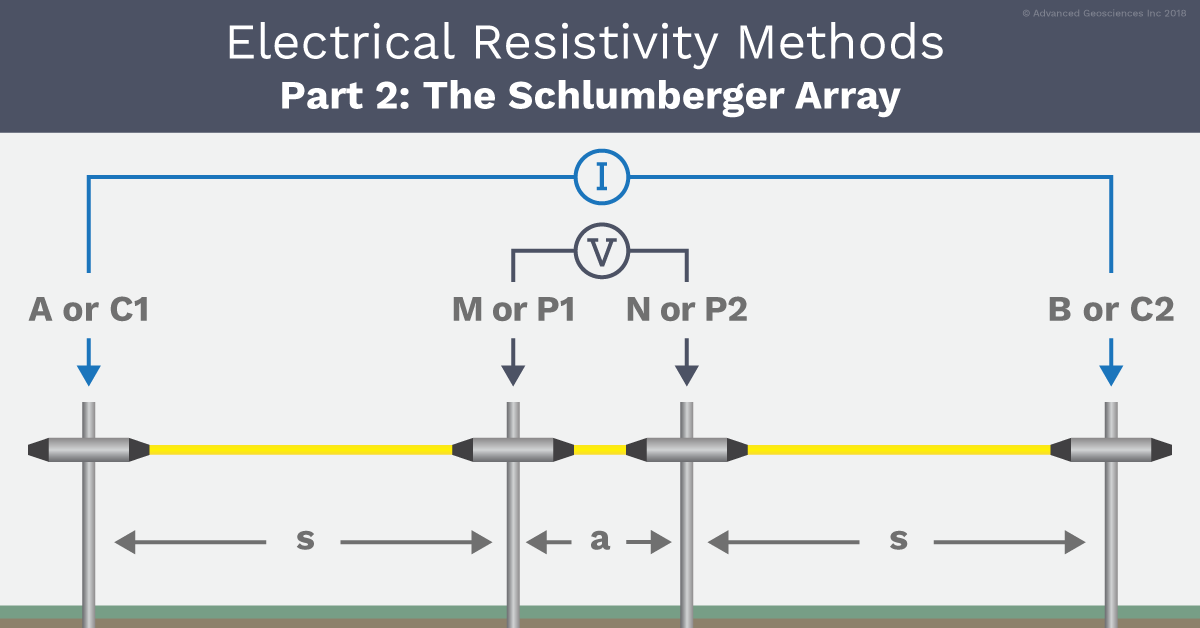
Electrode arrays are different arrangements of electrodes used to perform geophysical resistivity measurements. Electrode arrays were developed in order to make field measurements more efficient and data interpretation easier.
This is the second article in our series exploring 11 electrode arrays and methods. We’ve also covered the Wenner array. Today, we’re discussing the Schlumberger array.
What is the Schlumberger array?
The Schlumberger array is an array where four electrodes are placed in line around a common midpoint. The two outer electrodes, A and B, are current electrodes, and the two inner electrodes, M and N, are potential electrodes placed close together.
With the Schlumberger array, for each measurement the current electrodes A and B are moved outward to a greater separation throughout the survey, while the potential electrodes M and N stay in the same position until the observed voltage becomes too small to measure (source). At this point, the potential electrodes M and N are moved outward to a new spacing. As a rule of the thumb, the reasonable distance between M and N should be equal or less than one-fifth of the distance between A and B at the beginning. This ratio goes about up to one-tenth or one-fifteenth depending on the signal strength.

Background
The Schlumberger array is named for Conrad Schlumberger, founder of the modern-day Schlumberger oilfield services company and pioneer of electrical methods in the early 1900s.
Applications, Benefits, & Considerations Of The Schlumberger Array
The Schlumberger array is commonly used for vertical electrical sounding (VES) for groundwater and aggregate minerals. Vertical electrical sounding (VES) using the Schlumberger array provides better resolution, and take less time to deploy than the Wenner array (source).
The Schlumberger array is the best method for VES for practical reasons—it is significantly less labor-intensive than the Wenner array. For VES in general, the Schlumberger array is at advantage, because most of the time only the outer electrodes A and B need to be moved. A crew of three people is normally enough for VES—with two people moving the outer electrodes, the instrument operator typically moves the inner electrodes the few times they need to be moved.
The Schlumberger array is also used for mapping or profiling for lateral resistivity changes. The typical profiling is done by larger fixed AB current electrode pairs and moving MN potential electrode pairs between them. It is also done like Wenner profiling with fixed four ABMN electrode spacing The disadvantage of using profiling, regardless of using the Schlumberger or Wenner arrays, is that it demands homogeneous horizontal layers, which hardly ever occur naturally. The Schlumberger array may also be difficult or confusing for crews to carry out, which may be the reason why the Wenner array has been specified for profiling soil testing according to the ASTM G57 standard.
Resources & Related Information
-
A Comparison Of 11 Classical Electrode Arrays
-
1D Geophysical Resistivity Survey: Vertical Electrical Sounding
Questions about the Schlumberger array?
We’ll be happy to respond to any comments or questions you have about the Schlumberger electrode array or any other arrays. Simply fill out the form on this page, and we’ll be in touch.

